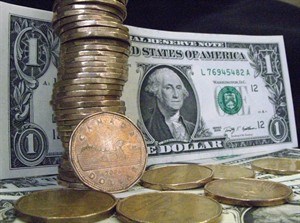
Canadian dollar coins, or "loonies," are shown with U.S dollars April 6, 2010. THE CANADIAN PRESS/Ryan Remiorz
January 15, 2013 - 5:45 AM
TORONTO - Canada's commodity-sensitive dollar was lower Tuesday morning as a stronger U.S. greenback pressured prices for oil and copper.
The loonie fell 0.22 of a cent from Monday's close to 101.43 cents US.
The American dollar strengthened amid growing concerns about a political standoff in Washington over the U.S. government’s debt ceiling.
On Tuesday, Fitch Ratings warned that the United States could lose its top credit rating for the second time if there’s a delay in raising the ceiling.
Congress has to increase the country’s debt limit by March 1 or face a potential default. There are fears that the debate will descend into the sort of squabbling and political brinkmanship that marked the last effort to raise the ceiling in the summer of 2011.
The higher U.S. dollar helped send commodities lower because a stronger greenback makes it more expensive for holders of other currencies to buy oil and metals which are dollar-denominated.
Commodity prices were lower with February crude on the New York Mercantile Exchange down 36 cents to US$93.78 a barrel.
March copper shed two cents to US$3.62 a pound while February bullion gained $13.90 to US$1,683.30 an ounce.
On the economic calendar, the Commerce Department reported that December retail sales were up 0.5 per cent, better than the 0.2 per cent rise that economists had expected.
The strong retail showing was a relief to traders who worried that consumer spending would slow during the month during a tense debate in Congress over tax increases.
A 1.6 per cent jump in sales of autos and auto parts led all categories. Car companies closed out their best sales year since 2007.
Overseas, Germany’s economy grew by a modest 0.7 per cent in 2012 as Europe’s biggest economy slowed under the weight of the eurozone debt crisis.
No fourth-quarter figure was given for gross domestic product, but the full-year total underscored what economists have been suspecting for some time — that Germany turned in negative growth in the fourth quarter. Growth was 0.8 per cent in the first quarter, 0.3 per cent in the second and 0.2 per cent in the third.
Analyst Carsten Brzeski at ING said the numbers showed that the German economy shrank by three-tenths to four-tenths of a per cent in the fourth quarter.
News from © The Canadian Press, 2013